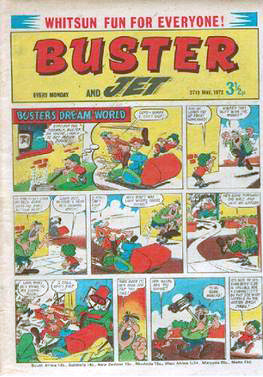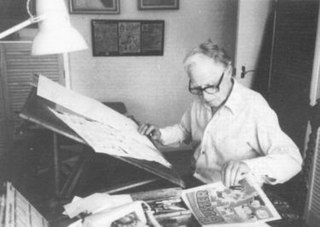
Buster was a British comic which began publication in 1960, originally published by IPC Magazines Ltd under the company's comics division Fleetway, then by Egmont UK Ltd under the same imprint until its closure in 2000. Despite missing issues due to industrial action during its run, the comic published 1,902 issues in total. The comic carried a mixture of humour and adventure strips, featuring the title character Buster and a host of other characters.

Whizzer and Chips was a British comics magazine that ran from 18 October 1969 to 27 October 1990, when it merged with the comic Buster. As with most comics of the time, Whizzer and Chips was dated one week ahead of the day it actually appeared on newsstands in Great Britain. It had no relation to the earlier British comic Illustrated Chips.
Jackpot was a British comic book magazine that ran from the issues cover dated 5 May 1979 to issue 141, 30 January 1982, when it merged with Buster.

Wow! is a British comic book magazine running for 56 issues from 5 June 1982 to 25 June 1983, when it merged with Whoopee!.

Knockout was a weekly British comics periodical published by Fleetway Publications from 12 June 1971 to 23 June 1973. A humour comic, the title ran until 1973 before being merged with another Fleetway title, Whizzer and Chips.
Lazy Bones was originally a comic strip in the British comic Whizzer and Chips. It made its first appearance in 1978.

Reginald Edward Parlett was an artist from England who had a career of drawing for comic books that lasted for 66 years.
Sweeny Toddler was a British comic strip by Leo Baxendale, which originally appeared in the British magazines Shiver and Shake, Whoopee!, Whizzer and Chips and finally Buster between 1973 and 2000. It was a gag-a-day about a little mischievous toddler. The name is a play on Sweeney Todd.
The Bumpkin Billionaires was a British humoristic comic strip which ran from 1974 until 2000. It was drawn by Mike Lacey throughout except for the last years in Whizzer and Chips by Jim Hanson.
Store Wars was originally a comic strip in the British comic Whizzer and Chips. During its run it was drawn by Doug Jensen, Jim Watson and Jimmy Hansen.
Sid's Snake was a comic strip in the British comic Whizzer and Chips. It first appeared in issue 1, dated 18 October 1969, and was originally drawn by Mike Lacey; Jimmy Hansen later took over.
Sweet Tooth was a British comic strip, created by Trevor Metcalfe in January 1973 and first published in the magazine Whizzer and Chips. When the magazine merged with Buster in 1990 the series continued until the magazine was disestablished in 2000.
Junior Rotter was a British comic strip, created by Trevor Metcalfe in 1980. The series were originally published in the magazine Whizzer and Chips, and from 1990 on in Buster when the two magazines merged.
Tom Paterson is a Scottish comic artist who drew characters for Fleetway in 1973–1990, and D.C Thomson from 1986 to 2012. As of 2013, he currently draws strips for Viz. He lives in Leith, with three children, and is a Hearts supporter.
Mustapha Million was a British gag-a-day comic strip, created by Reg Parlett. It appeared in Cheeky Weekly in its first issue on 22 October 1977. The magazine would later merge with Whoopee! and on its turn with Whizzer and Chips, while the comic ran in those magazines as well.
Bobby's Ghoul was a comic strip originally appearing from 29 August 1992 until 1995 in the British comic magazine Whizzer and Chips, and later Buster after the two comics merged. One of the artists was Anthony Hutchings.
Memory Banks was the name given to a comic cartoon strip created by Mark Bennington, which appeared in Whizzer and Chips and then went on to appear in Buster.

Illustrated Chips was a British comic magazine published between 26 July 1890 and 12 September 1953. Its publisher was the Amalgamated Press, run by Alfred Harmsworth. Priced at a half-penny, Illustrated Chips was among a number of Harmsworth publications that challenged the dominance in popularity of the "penny dreadfuls" among British children.
Sidney William Burgon, better known as Sid Burgon, is a British comics artist. After working as a mechanic and drawing as a hobby he was encouraged by coworkers into furthering his artistic interests. He gave up his job in 1963 and became a freelance cartoonist with some of his early work being published The Weekly News under the pseudonym Swab. In 1970 Burgon began working for Fleetway drawing a number of strips including Bookworm for Whoopee!, Joker for Knockout and Ivor Lott and Tony Broke for Buster (comics). Burgon began to draw for DC Thomson in 1989 drawing a revival of Biffo the Bear in The Beano and Adrian the Barbarian for The Beezer. Burgon stopped drawing for DC Thomson in the late 1990s/early 2000s and is currently retired.
Pursuit of the Puzzler was originally an adventure comic strip in the British comic Whizzer and Chips. It made its first appearance on 2 January 1971 and ran for 82 weeks concluding with the issue dated 29 July 1972. The Puzzler adventures were drawn by noted artist and illustrator Mike White.






